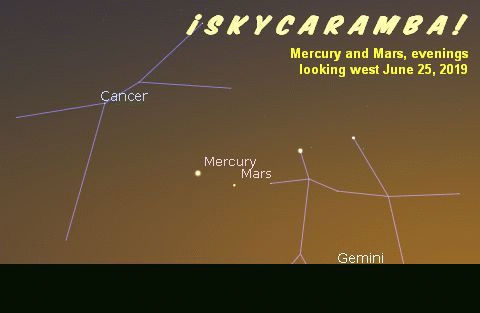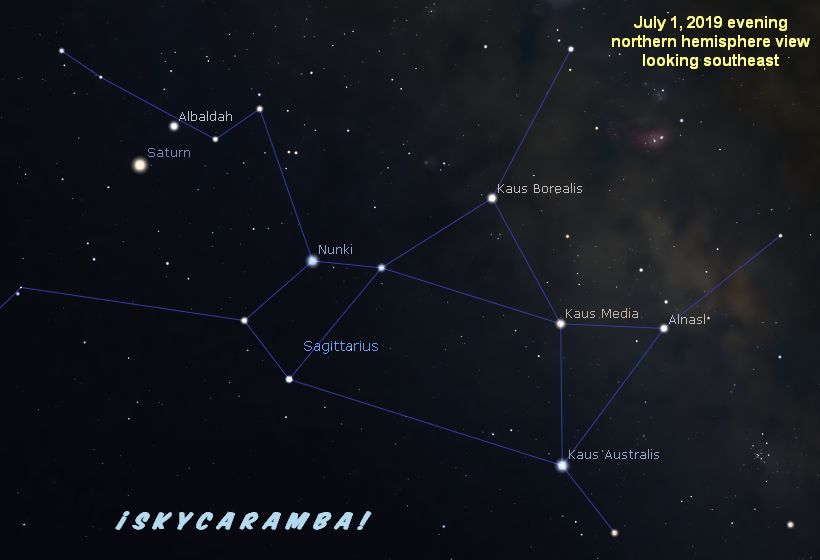
Mercury and Mars are paired in the dusky glow at the start of July. The moon passes by on the 3rd. You don’t get many more evenings to see Mercury though. It quickly drops below Mars and sets too soon after sunset to be seen. Mercury is at inferior conjunction on the 20th. You don’t have a lot of evenings to see Mars either. It’s also retreating into the sunset. If not for the twilight, the red planet might be an awesome sight in the Beehive cluster on the 13th.

Jupiter and Saturn are up in the southeast already as darkness begins. The red star right of Jupiter is Antares. Saturn remains near the teapot lid of Sagittarius. The moon passes by Jupiter on the 13th. Then it goes by Saturn two nights later. Both planets are retrograde. That means they’re moving westward on the background of stars behind them. They are slowly moving, but with careful comparisons you should be able to see the movement over the span of several nights.

Saturn’s motion is easier to spot because it is near an easily seen star. Albaldah is about 510 light years away. Saturn is a mere 9 astronomical units away. Another way of putting it, although the planet and the star are next to each other in our sky, the star is about 3.58 million times as far away from us. Or to use light time, Saturn is 1 hour, 14 minutes, 50 seconds away from us.

In the morning sky, Venus is close to the horizon and recessing into the sunrise. The moon is right of the planet on the 1st. Because Venus is so bright, you won’t have much trouble finding it during the first half of the month as long as your horizon is clear. You probably won’t see many, if any, of the stars of Gemini behind it though.
Earth is at aphelion on the 4th, at a distance of 1.017 astronomical units. Mercury is at aphelion at the 7th at 0.467 au from the sun.
The new moon is also at northern lunistice on the 2nd. Perigee on the 5th is 363,700 km distant center-to-center. The moon crosses the equator going south on the 9th when it’s at first quarter. Southern lunistice is on the 15th, followed by full moon on the 16th. So expect a southerly full moon. The moon goes north again on the 23rd. Last quarter is on the 25th. Northern lunistice occurs again on the 30th.

The southern Pacific Ocean and South America get a solar eclipse on July 2. The path of totality crosses Chile and Argentina.

A partial lunar eclipse will be visible on July 16 from most or all of South America, Africa, Europe, Asia, and Australia. From 20:01 UT to 23:00 UT, the northern half of the moon will pass through the earth’s shadow.
Some notable conjunctions this month:
5th Mercury and Mars, 3.8°
21st Mercury at inferior conjunction
22nd Venus and Pollux, 6.0°
25th Mercury and Venus, 5.6°
Other conjunctions involving the moon and various objects:
1st Venus, 1.6°
3rd Pollux, 6.1°
4th Mars, 0.1°
4th Mercury, 3.2°
6th Regulus 3.1°
9th Spica 7.3°
12th Ceres 2.9°
13th Antares 7.8°
13th Jupiter 2.3°
16th Saturn 0.2°
21st Neptune 3.6°
25th Uranus 4.5°
26th Vesta 2.3°
28th Aldebaran 2.2°
31st Mercury 4.5°
31st Pollux 6.1°
31st Venus 0.6°

The moon will pass in front of Saturn on the 16th for viewers in the southern Pacific Ocean and South America. The time of the central conjunction is 07:15 Universal Time.
Careful viewers may see a daytime occultation of Venus on the 31st. You need to be in northeast Asia and northern parts of North America. The central conjunction time is 20:36 UT. Venus can be seen during daylight. But since Venus is so close to the sun on the day of conjunction, one must be very cautious not to accidentally look at the sun while waiting for the planet to disappear and reappear. This is probably not a daytime occultation for beginners.

In the later half of July, try watching for Delta Aquariid meteors. You’ll need to look between midnight and dawn. The meteors appear to come from a star named Skat in Aquarius. The peak date is around July 30. You may see 15 to 20 meteors per hour. Comet 96P/Machholz is the parent. Its period is 5.29 years. The comet was last at perihelion in October 2017.

Left to right: Neil Armstrong, Michael Collins, Buzz Aldrin
Image from Wikimedia Commons
This month marks 50 years since men first walked on the moon. Apollo 11 launched on July 16, 1969. Four days later, the lunar module named Eagle landed on the moon. It was July 21 Universal Time (still July 20 in the United States) when Neil Armstrong and Buzz Aldrin stepped out onto the moon’s surface. The astronauts returned to Earth on July 24.
While Armstrong and Aldrin got the thrill of walking on the moon and typically get all the attention for being the first to do it, their feat happened because of the efforts of thousands of men and women who put countless hours into studying everything astronauts could need in space and determining what it would take to get to the moon. The most important person on the Apollo 11 mission was arguably the one who didn’t get to set foot on the lunar surface. Michael Collins manned the command module as it went round the far side of the moon. His job was to keep everything working and in the proper orbit to rendezvous with Armstrong and Aldrin as the lunar module left the moon’s surface. And then all three could return to Earth.
